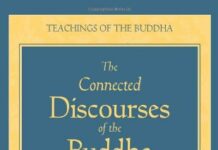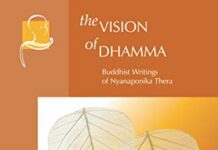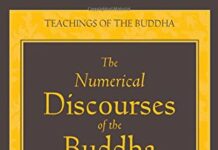
Ebook Info
- Published: 2020
- Number of pages: 120 pages
- Format: PDF
- File Size: 0.69 MB
- Authors: Bhikkhu Bodhi
Description
This book offers a clear, concise account of the Eightfold Path prescribed to uproot and eliminate the deep underlying cause of suffering—ignorance. Each step of the path is believed to cultivate wisdom through mental training, and includes an enlightened and peaceful middle path that avoids extremes. The theoretical as well as practical angles of each of the paths—right view, right intention, right speech, right action, right livelihood, right effort, right mindfulness, and right concentration—are illustrated through examples from contemporary life. The work’s final chapter addresses the Buddhist path and its culmination in enlightenment.
User’s Reviews
Reviews from Amazon users which were colected at the time this book was published on the website:
⭐So well articulated, it carries you along the Noble Eightfold Path. The joy in discovering this overview of the Path motivates the careful cultivation of the practice which leads to transformation and happiness. Highly recommended for those just starting as well as those continuing.
⭐How much is enough? Not everyone will agree on any given answer to this question, but I will add my vote for 5 stars to those who voted the same way. Having read nearly all of the Sutta Pitaka, as much of the Visuddhimagga as I could tolerate, and numerous commentaries on Buddhist thought by more modern commentators, I am hard pressed to think of any important precept that cannot be found in this little volume by Bikkhu Bodhi. As he says in the preface, “The essence of the Buddha’s teaching can be summed up in two principles: the Four Noble Truths and the Noble Eightfold Path. The first covers the side of doctrine, and the primary response it elicits is understanding; the second covers the side of discipline … and the primary response it calls for is practice. In the structure of the teaching these two principles lock together into an indivisible unity called the dhamma-vinaya, the doctrin-and-discipline…”Buddhism is, after all, a prescription for conducting one’s life in a way that leads to harmlessness (ahimsa), happiness, awareness (samadhi), and understanding (panna), and the foundation of the whole teaching is right behavior (sila). The nature of Buddhist discipline is experiential, not intellectual, and the goal of practice, nibbana, can be reached just as well by the illiterate as by the scholarly. In fact, it may be that the illiterate have an advantage in one respect, being less likely to get caught up in their conceits and the pride of their minds (see Romans 12:16). Knowledge is important, but it is also important to recognize how easily one can lose track of the Middle Way in a maelstrom of words. It know it seems odd to refer to Judeo-Christian scriptures in a review of a Buddhist text, and I hope to be forgiven for it if that is perceived wrongly, but truth is where you find it, and I can think of no more eloquent way of expressing the caution I have in mind than this: “For in much wisdom is much grief: and he that increaseth knowledge increaseth sorrow (Eccl 1:18).” It is not necessary to memorize the ethical principles of Buddhism from some book or exegetical commentary because human beings, for the most part, have an innate ability to recognize what is skillful and what is not ((Genesis 3:5). It is through their words and conceptual convolutions that humans become confused and lost. Maybe that explains what happened to Sangharakshita. I don’t know anyone that hasn’t gone down that path, or one similar to it, at one time or another. Mindfulness is the cure.Personally, I believe this is the best of Bikkhu Bodhi’s writings. It is clear, concise, and complete, and I thank him for it. What remains to be done is practice with hope and faith that one lifetime is sufficient.
⭐This is the type of book that a “review” of it almost seems beside the point. What you bring to reading it is going to account for at “least” 50% or more of how much you might get out of it.If your interest is mostly academic, or you’re merely curious about the general principals of Buddhism, I doubt that it’s going to be what you’re looking for. That’s not a knock on readers just looking to dip their toes in, so to speak. Just that it’s better to know what you’re getting and not come away confused, frustrated or disappointed when maybe it’s just the wrong book to start with. In my opinion, this is a book for the kind of person who already has a firm foundation in mediation, and perhaps is already far enough along to “see through” what we might call everyday “reality”. If that statement seems a little far-fetched or “out there” to you, then my guess is that there are probably other books around the teachings of Buddhism that would be better suited for you. Put another way: if you’re looking for a good primer on mathematics, don’t start with advanced calculus, right? Get comfortable with the basics, then work your way up to the harder stuff.My Experience: This book, obviously written more recently the original teachings of the Buddha is very clearly written, and benefits from a modern language translation. It doesn’t really “add” much the original texts per se, but for me it’s better organized and more concisely presented. He also takes the time to address various concepts both for the “lay person” (i.e. non-monk or nun) as well as the “full-time” devotee. My guess is that 95% of the readers will be in the former category, at least for English readers. All of this makes it even more practical in terms of applying these ideas, and I personally have really connected with every section. I have the Kindle edition and have bookmarked and highlighted numerous passages, and will be using this as my guide for years to come.
⭐This is likely an excellent book for somebody who reads a lot of literature. For somebody who’s just getting started and doesn’t have a lot of experience reading books in the past other than School this book is a little above my head. Not because of the content but because of the choice of words that this author has selected. Within the first few chapters I have probably Googled 10 different definitions of words. Instead of common words that we all know the author chose to find the most extravagant biggest word to use for their explanation. So for me I have to stop and Google and then come back to it and that’s not helpful for my personal Journey. I’m stopping at chapter 3. It’s too frustrating to try to read this book. Frustrating mostly because I’m not a stupid person I got an A+ in philosophy and literature in College last semester. I read Siddhartha in that class which has led me on this journey to Buddhism but I really dislike this book. I love both of Noah Rashadas books on Buddhism and I hope to find others that I can read easily and enjoy and receive the message.
⭐This small and concise book – it is small in physical dimensions and has 144 pages including all the prelim and appendix pages – manages to condense all the really important aspects of the teachings of Buddha Gautama. I would recommend this book for those wanting to find out more about Buddhism and those already practising. Most, if not all, of the important Buddhist terms and concepts are referenced in Pali, the language of the earliest Buddhist writings, which the author, a practising Buddhist and translator, is well qualified to explain. It is not only concise but very clear, easy to read in plain english and well ordered. By continually referring to the Buddha Gautama’s teaching, one gets a sense that, whilst this is not a Sutra/Sutta in itself, it is a true transmission of the practical help towards Liberation that Buddha Gautama gifted us with, which lifts the publication towards canonical status. Although it will be of interest to the casual or academic reader, its real value is to anyone either seeking the essence of Buddhism or as a guide for further study and practice with or without a spiritual teacher. Wholly recommended with grateful thanks to the author, Bhikkhu Bodhi for his gracious efforts to light up The Way and to the publishers BPS Pariyatti Editions for distributing this flame of wisdom.
⭐My favourite Buddhist book. A handy size yet clearly and concisely covers vast terrain. Definitely enough here to inspire a lifetimes work; very good companion to keep revisiting as ones journey unfolds and as ones outlook and priorities changes.I’m particularly fond of the style of writing. It is very engaging, almost academic, intelligent, whilst the writer keeps things as impersonal and as free of his own prejudices and opinions unlike some of the other authors I have come across.A must buy. I’d like to read more of his expositions.
⭐This is a gem of a book, and I can say that it is currently the best book that I own.The Noble Eightfold Path is a very comprehensive and sophisticated psychology, philosophy, and spiritual practice. As a sports and exercise scientist I am in awe of its level of brilliance.I have been seeking a path (I think I’ve found it). I have been researching and studying various esoteric sciences including Hermeticism, Kabbalah, Alchemy, Qigong, Taoism, and now Buddhism.This is a very clear and beautifully written book. I would recommend it to all of humanity.
⭐Buy this book! It has done more to enhance my intellectual understanding of the holistic nature of the path and inspire me to persist in my efforts of mindfulness than any other resources on Buddhism.Unlike most other dialogues on the path, which inform us that the whole idea of thinking of the path is misleading, because ‘all the aspects are equally as important’ this book actually treats the path, well, as a path – You start with stage 1 – Right Understanding, then develop through moral purification – stages 3-5, and these set the foundations for the great effort invovled in mindfulness and meditation practises.Having finished, reread and taken notes on the book I have realised my previous approach to Buddhism was somewhat wishy-washy, and am now enthused about the prospect of perservering in right effort to ‘kill my mind’ and refine my consciousness.I am deliberately not going to outline the content in too much depth for fear of not doing it justice, but if you are already into Buddhism I recommend it.
⭐This is a wonderful book, and compact enough that I carry it about with me and read it on bus and tube journeys. It spells out in detail each spoke in the eightfold path, and it is illuminating and uplifting.
Keywords
Free Download The Noble Eightfold Path: Way to the End of Suffering in PDF format
The Noble Eightfold Path: Way to the End of Suffering PDF Free Download
Download The Noble Eightfold Path: Way to the End of Suffering 2020 PDF Free
The Noble Eightfold Path: Way to the End of Suffering 2020 PDF Free Download
Download The Noble Eightfold Path: Way to the End of Suffering PDF
Free Download Ebook The Noble Eightfold Path: Way to the End of Suffering



